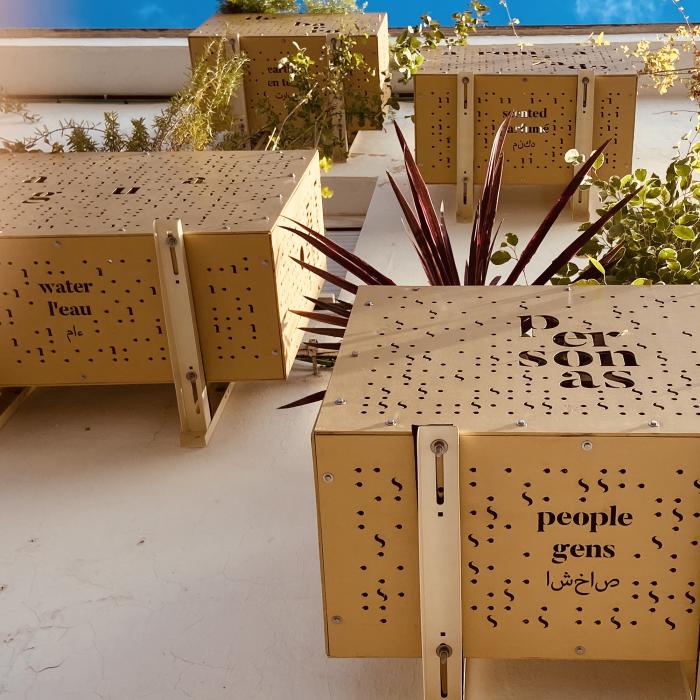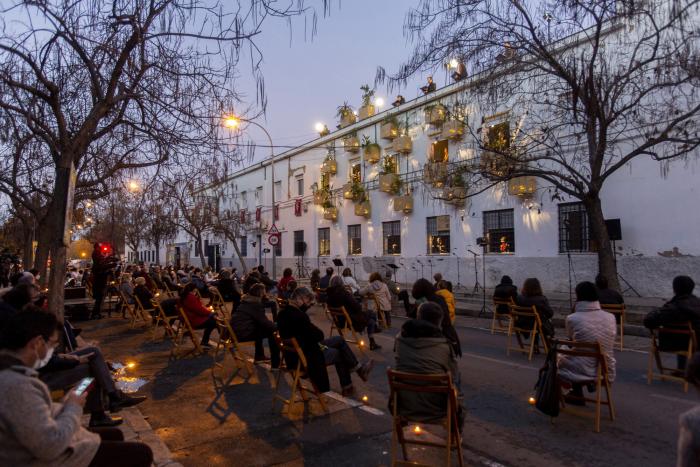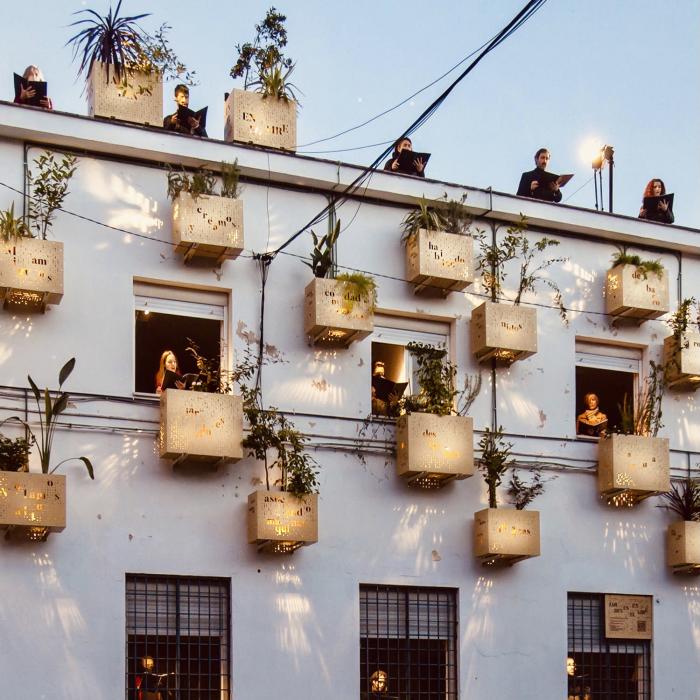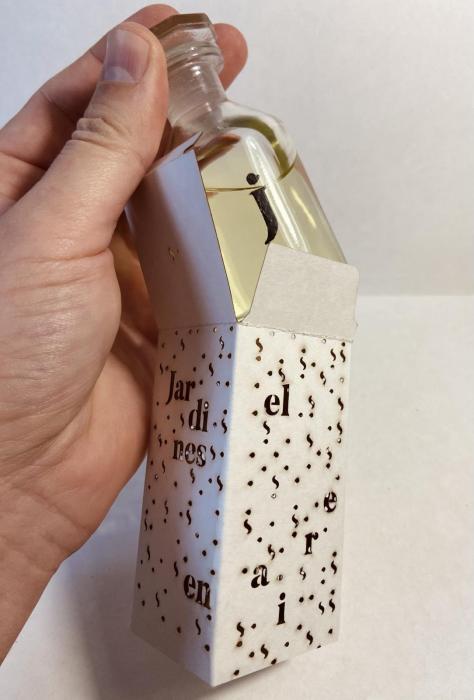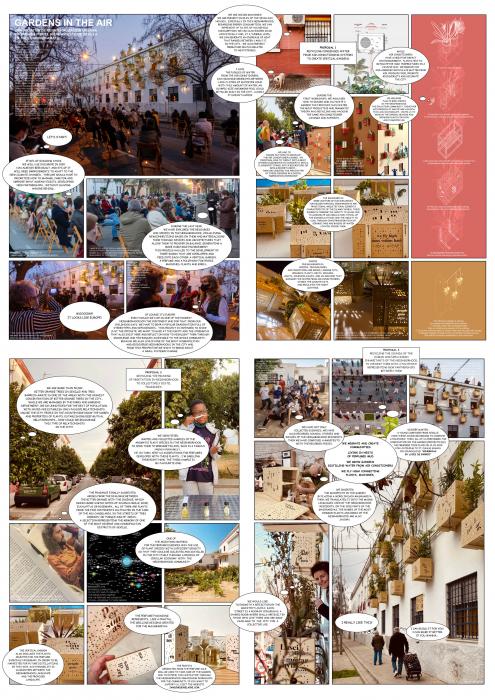I. SUMMARY INFORMATION
Project
269242
Status
Submitted
Award category
Buildings renovated in a spirit of circularity
You want to submit
NEW EUROPEAN BAUHAUS AWARDS : existing completed examples
Project title
Gardens in the Air
Full project title
Gardens in the Air (Neighbourhood Lights 2020) / Jardines en el Aire (Luces de Barrio 2020)
Description
A „Kertek a levegőben” városzöldítő projekt a sevillai Tres Barrios-Amatében. A régióban számos citrusfa nő, a SEO Birdlife nevű szervezet pedig egy madárvédelmi központot működtet az Amate parkban; a környék továbbá Spanyolország egyik legszegényebb területének számít. Lakói (idős emberek és bevándorlók) lepusztult lakásokban élnek, és a nyári kánikulát légkondicionálással vészelik át. Művészek, tudósok, építészek, designerek, lakók és az A.E.S. Candelaria nevű helyi szervezet fiatal tagjai egy esztendőn át tanulmányozták a helyi erőforrásokat, illetve állat- és növényfajokat. Művészeti és természetvédelmi műhelytalálkozókon keresték a választ arra a kérdésre, miképpen alakítható ki egy fenntarthatóbb élettér az emberek és a vadvilág számára, a művészetek bevonásával és új bevételi források generálásával. 2020 decemberében kialakítottak egy függőleges kertet, amely öntözéséhez a légkondicionáló kültéri egységeiből nyert víz használható; létrehoztak egy parfümöt, amely Tres Barrios-Amate leggyakoribb növényeinek illatát egyesíti magában, és érződik rajta a lakosság földrajzi eredetének változatossága, továbbá komponáltak egy többszólamú zeneművet („Sinergias”).
Where was your project implemented in the EU?
Spain
Andalucía
C/ Candelilla, 6
37.38239
-5.95686
Sevilla
41006
When was your project implemented?
Has your project benefited from EU programmes or funds?
No
Which programme(s) or fund(s)? Provide the name of the programme(s)/fund(s), the strand/action line as relevant and the year.
II. DESCRIPTION OF THE PROJECT
Please provide a summary of your project
Gardens in the Air is a circular initiative of urban renaturalisation in the neighbourhood of "Tres Barrios-Amate" (Seville) with the participation of local creators, neighbours and young people from the local association A.E.S. Candelaria.
A proposal that materialises in three interconnected works, matured over a year of workshops, meetings and shared celebrations, with the aim of exploring the resources and species of the neighbourhood, to imagine new relationships that allow them to thrive in balance, generating a more sustainable habitat.
A vertical garden located on the façade of the No. 6 - Candelilla building that reuses water from air conditioning machines to grow species adapted to these conditions. A project created in collaboration with Collateral Studio, Estudio Pätē, I.Vega and Fablab Sevilla, together with students from A.E.S Candelaria.
A perfum made from a selection of the most representative plants of the neighbourhood, reflecting the diversity of human origins that make it up. A limited edition of 333 bottles made by the Parisian nose Barnabé Fillion with the help of T.Pradet. The perfume is purchased in exchange for a donation to the art and nature workshop programme that continues at A.E.S. Candelaria, whose next challenges are the improvement of the prototypes, the sensorisation of the garden and the production of essential oils from nearby plants.
A polyphony created from the multiple voices - human and non-human - of the neighbourhood, collected by the young people in the workshops held with Antropoloops, Vibra-tó, SEO Birdlife and Amigos del Parque Amate and which has taken shape in "Sinergias" under the direction of the composer Desirée Martín and the interpretation of Proyecto eLe.
Gardens in the Air is a project of ICAS - Seville City Council and Ecosistema 41 with the support of Fundación Banco Sabadell and the collaboration of Cátedra EMVISESA , curated by Nomad Garden, produced by El Mandaito and communication by Surnames.
Please give information about the key objectives of your project in terms of sustainability and how these have been met
Located between Amate Park and the old Tamarguillo riverbed, the streets of the neighbourhood are home to one of the highest densities of citrus trees in the city. Amate Park is one of the largest and most diverse parks in Seville, as well as being the centre of activities of associations such as Amigos del Parque Amate, or SEO Birdlife, which promotes birdlife in the area. A community that, precisely, gives the neighbourhood its name and identity. Beyond symbolic issues, we understand that reflecting creatively on the reciprocal and mutualistic relationships between humans and non-humans can be an opportunity to create efficient and exuberant ecotopes. Therefore, the project aims to enhance the value of aromatic and avian species in the neighbourhood, as well as to promote the increase of biodiversity, complexity and ecosystem services of urban vegetation through participatory citizen actions, promoting the city as a garden of coexistence through arts and sciences.
In addition, Seville has a severe climate in the summer season where temperatures reach 45ºC for several hours of the day in summer. With a housing stock built in the 1950s, the dwellings in Tres Barrios - Amate do not exceed 50m2 of usable surface area and the height of the interiors varies between 2.30m. This obsolescence accentuates the proliferation of air conditioning machines on the façades of the buildings that combat the heat inside the homes for hours at a time. Each machine can condense between 1 and 2 l/h of water discarded on the pavements, which serves as a spring for birds and as irrigation for wild acidophilic species. From this perspective, Gardens in the Air proposes hacking the machines through the prototype of a community urban DIY aimed at improving the thermal, energetic and aesthetic conditions of buildings by using the water discarded by the air to create vertical gardens with species adapted to these conditions to create a cooler, more diverse and habitable outdoor landscape.
Please give information about the key objectives of your project in terms of aesthetics and quality of experience beyond functionality and how these have been met
We aim to graft onto the technological circuit of air conditioners a biological and artistic "plug-in" that shades and decorates the built-up park of the neighbourhood. In this way, the air-conditioning machines become, functionally and aesthetically, the triggering element of vertical gardens managed from the windows of the houses. A strategy that allows the water generated by them to be recycled to extend the domestic beyond, creating a membrane of biodiversity that, like a Trojan horse, helps to minimise the need to use these appliances, as well as creating, through addiction, a fresher and more habitable exterior landscape for everyone. As Louis I. Kahn argued, "the street is a consensual room. A communal room whose walls are contributed by those who inhabit it, ceded to the city for its collective use".
The vertical garden has been designed by local creators in workshops with young people and is supported by "masharabiyas", 19 wooden boxes with ventilation lattices inspired by Islamic architecture that contain clay pots with plants inside them, enhancing the evapotranspiration capacity of this local material in the manner of a "botijo".
On an aesthetic level, the design of the pattern of holes has been created from the typographic combination of the message composed by the neighbours as a manifesto. In this way, functionality and symbolism are harmoniously integrated. The message reads:
WE MIGRATE AND CREATE COMMUNITIES INHABITING NESTS OF SCENTED MUD
WE CULTIVATE GARDENS BY DISTILLING WATER FROM THE AIR
WE FLY HIGH ASSOCIATING PLANTS AND MACHINES PEOPLE AND BIRDS
The same strategy of die-cutting has been taken to the design of the perfume packaging, to encourage its dispersion in the environment.
Please give information about the key objectives of your project in terms of inclusion and how these have been met
Tres barrios - Amate is one of the poorest neighborhoods in Spain. Consisting of obsolete housing blocks with 5 floors and no elevator, it is mostly inhabited by the very old local population or migrant whose perspective is to be passing through.
In this sense, the project tries to rescue the potential resources of the neighborhood through the joint work of young people from the neighborhood with creators from the city, provoking a process that culminates in the celebration of the works in the busiest street of the neighborhood and brings art and contemporary culture closer to its neighbors.
The formalization of a new collective landscape materializes in Calle Candelilla 6, the social facility that brings together the neighborhood's community activities and is home to several social entities. Among them is the AES Candelaria, which has been in existence for 40 years and has been able to adapt to the different stages and needs of the neighborhood. It currently carries out educational activities with more than 400 young people of many different nationalities - Ecuador, Bolivia, Colombia, Morocco, Burkina Faso - strengthening the community and coexistence between cultures. With them, we have translated the "masharabiyas" manifesto into the most widely spoken languages in the neighborhood: Spanish, English, French and Arabic.
The dialogue with other species is established through a polyphony that includes the multiple voices -human and non-human- of the neighborhood, compiled in sound recording workshops carried out with Antropoloops, Vibra-tó, SEO Birdlife and Amigos del Parque Amate together with the educational community. This work takes shape under the direction of composer Desirée Martín in the composition "Sinergias", performed by Proyecto eLe.
On December 20, 2020 Candelilla Street was closed to traffic and the noise was transformed into music, turning the road into an open-air theater, the vegetated scenery shone all Christmas.
Please give information on the results/impacts achieved by your project in relation to the category you apply for
The project has covered around 30,000 nearby inhabitants who will see the work during the year that it will be on display on the façade of Calle Candelilla.
128 people participated in the workshops.
Qualitative impact
18 students have participated in the activities
18 creative teams made up of 55 people
148 people attending the closing of the summer workshops
300 people attending the concert in Calle Candelilla 6
Quantitative impact
Indirect beneficiaries (families, entities and agents involved): an estimated 15,279 people, broken down as follows
Members and participants (students, monitors, educators) of AES Candelaria. 300 young people, 25 educators, families ~975 people.
Members and participants of the other associations in the building. ~250 people.
Families of the 18 students of the workshops. ~54 people.
Neighbours of the neighbourhood. ~14,000 people.
Number of web views of the project: 2,544 sessions and 1,163 unique users* (9,524 page views between 1 July 2020 and 14 February 2021).
Media impact
Audience (reach): 21,317,460.
Economic impact (economic return): €1,145,949.
Number of impacts: 53
382 stories have been created and shared on social networks, with a global reach of 73,115 impacts and 7,516 interactions with more than 172 thousand impressions.
The event has been published in national and international media.
Impact (impressions/outreach) on Social Networks (Instagram, Twitter, Facebook)
Impressions: more than 172,00.
Overall reach: 7,516 interactions with 73,115 impacts.
Stories shared: 382.
Circular economy
600 2ml samples of the perfume are being distributed through various channels.
A process of micro-patronage has been initiated, giving donors 333 bottles of perfume (50 and 100 ml). By May 30, 2021, the number of people who have donated amounts to 85 people (some of them with more than one donation), and a total of 105 perfumes have already been delivered in Spain and abroad.
Please explain the way citizens benefiting from or affected by the project and civil society have been involved in the project and what has been the impact of this involvement on the project
The Local Intervention Plan for Disadvantaged Areas of the Seville City Council 2018-2022 (PLIZD), contemplated the need to increase the cultural programme of the neighbourhood, as well as the offer of educational training for the youth community.
Given the deficient cultural and creative offer in the neighbourhood, the key objective was to generate an artistic process located in the neighbourhood, whose final beneficiaries would not only have a passive representation or audience, but would become the main actors of the work. To this end, the training and involvement of youngs between 11 and 16 years old from the AES Candelaria in the creation of the works was encouraged through the holding of creative art and nature workshops in which the environmental potential of the neighbourhood was explored, such as the bird life or the ability of aromatic plants to become perfumes.
The workshops were given by scientists, artists, architects, musicians and biologists from the city who come to the neighbourhood to work with a mature local community that is well aware of the real problems. A process that, we understand, generates cross experiences, broadening the knowledge of the artists and technicians about the diferentes realities of the city as a whole.
Over a period of nine months, 12 creative workshops have been held, offering young people of the AES Candelaria different training options in art and science, such as digital desing and fabrication with laser cutting, listening and recognition of birdsong and botanical explorations in the neighbourhood and Amate park, help in the creation of perfumes and candles with aromatic plants, sound recordings and interviews to veteran neighbours, creation of musical instruments and public presentations of the project to the media, tv, radio and audience on the day of the inauguration.
Please highlight the innovative character of the project
The project recycle water from air conditioning machines to make vertical gardens in buildings, which help to cool the environment and mitigate the heat produced on the facades due to solar radiation. A strategy that also enhances urban biodiversity and interspecies coexistence in the urban environment. In Seville, the amount of water produced by air conditioning machines amounts to 2 million liters per day in summer, the annual time of greatest water demand in plants. This figure should be taken into account and could be comparable to other cities in southern Europe where the population, climate, rainfall and temperatures are similar.
Recycle the pruning of urban plant species to produce essences and perfumes collectively in order to generate circular economies that mobilize and take advantage of local resources, promoting the care of urban nature in the suburbs as well as the knowledge of its ecosystemic benefits.
Recycle human and non-human voices and sounds of the neighborhood in sound works that promote rituals celebrating the links between them as if it were a new interspecies brotherhood.
In this sense, the creative process is accompanied by expressions that collect and transmit the links that connect us. Thus, it is not only presented as a "scene" but as an immersive experience that incorporates all the potentialities that it finds around it, illuminating a new microclimate, its own sonority, and even a specific aroma.
Please explain how the project led to results or learnings which could be transferred to other interested parties
Respect to the Garden created, it is appropriate to reflect on the possibility of organising this collective landscape as an addition of autonomous domestic micro-gardens - where each neighbour manages their own air conditioning, façade, plants, etc. - or if, on the contrary, it is more convenient to "design" an intermediate institution where different neighbours reach an agreement to manage several gardens at the same time, sharing common infrastructures that contribute to the resilience of the garden. We are referring, for example, to the centralised collection and storage of water for air conditioning or the introduction of an impulse pump with a shared solar panel for automated irrigation. In this mutualisation, it has been essential to visualise the positive and negative impacts of the operation, in order to encourage its adoption and replication by other neighbourhood communities or estate administrators in the neighbourhood. From this perspective, the interest of this project lies not only in the design of an object, a landscape or even a process, but in the institution or community itself, which enables the collective management of the environment.
The perfume promotes a new circular economy initiative for the neighbourhood centred on the collection and use of pruning waste from botanical species of identity and indirectly in the creation of collective gardens and artistic projects. From this perspective, the creation of perfumes is a proposal that can generate value by converting pruning waste into a resource for the extraction of essential oils. A well-articulated experience that can generate a lasting resource through which to finance other cultural or educational projects in the neighbourhood.
Finally, the polyphony "Synergies" is a specific localised work based on recordings of everyday sounds and interviews with neighbours, in order to sound out and precipitate their potential emotional ties.
Is an evaluation report or any relevant independent evaluation source available?
No
III. UPLOAD PICTURES
IV. VALIDATION
By ticking this box, you declare that all the information provided in this form is factually correct, that the proposed project has not been proposed for the Awards more than once under the same category and that it has not been subject to any type of investigation, which could lead to a financial correction because of irregularities or fraud.
Yes

